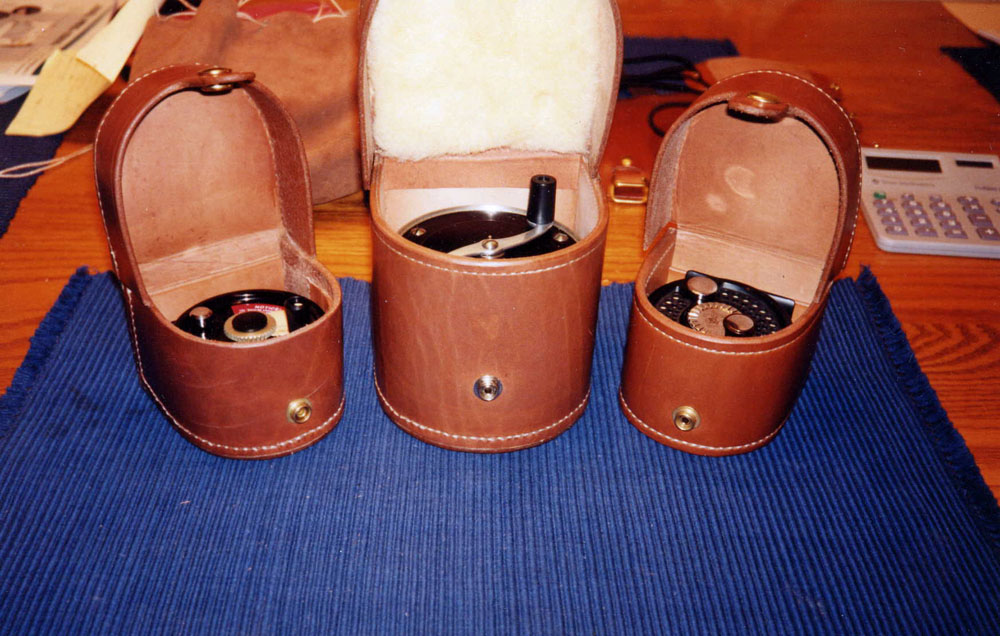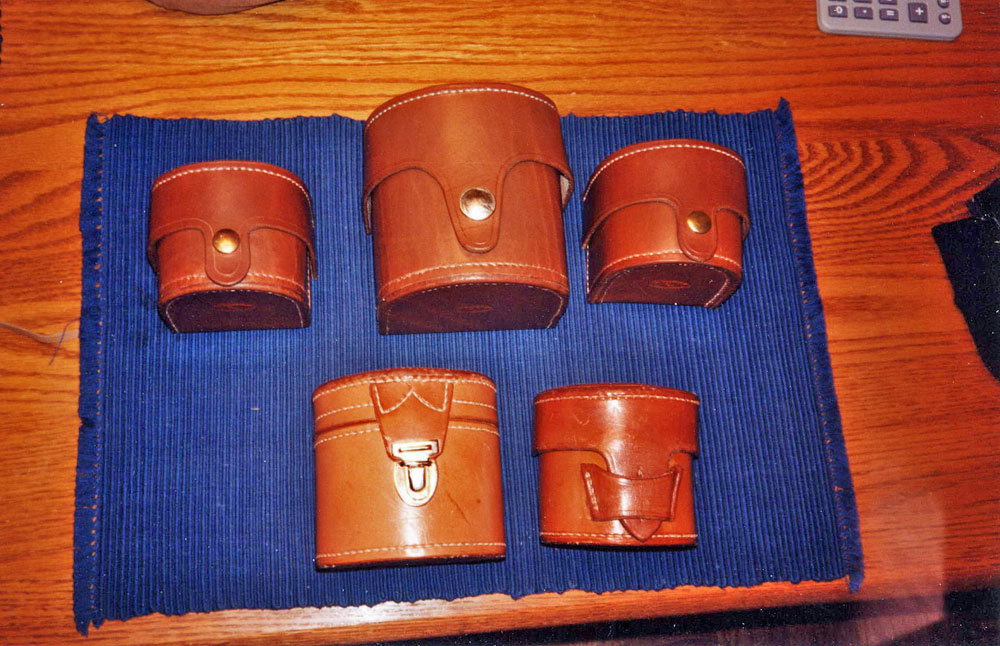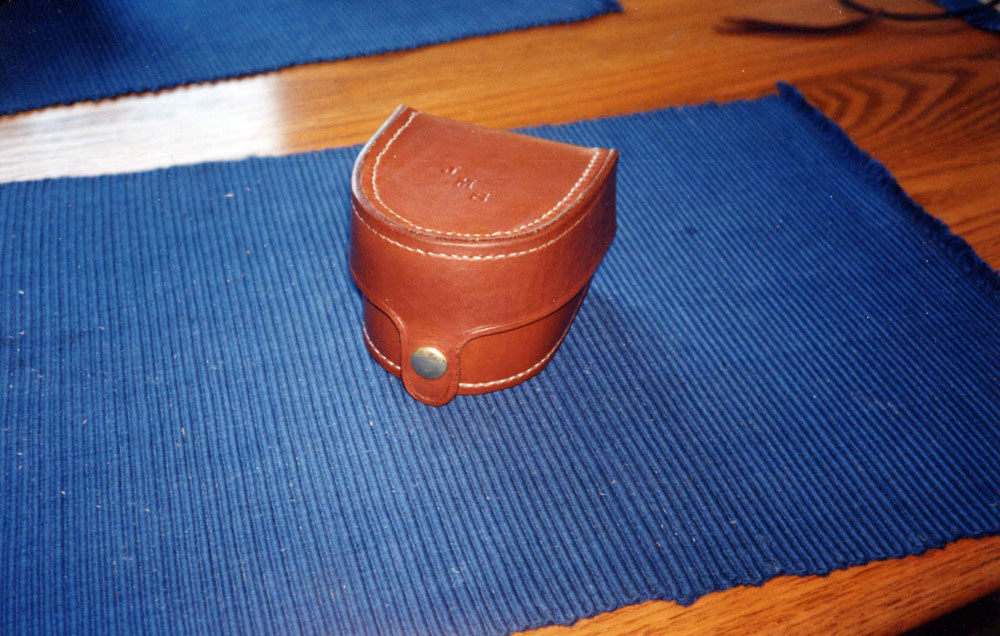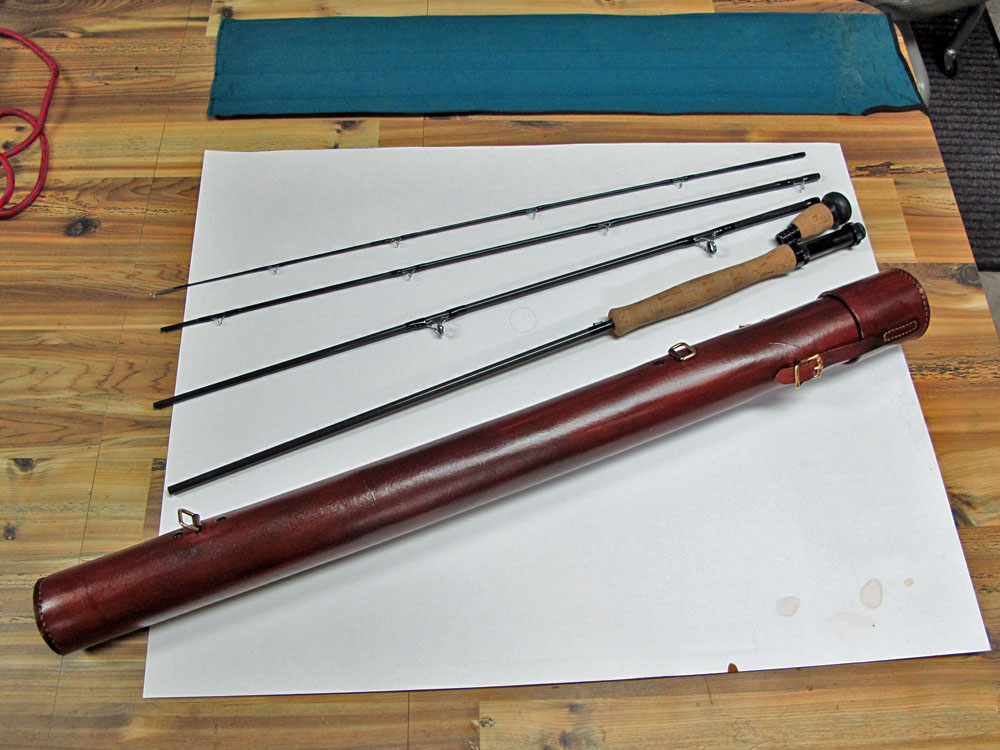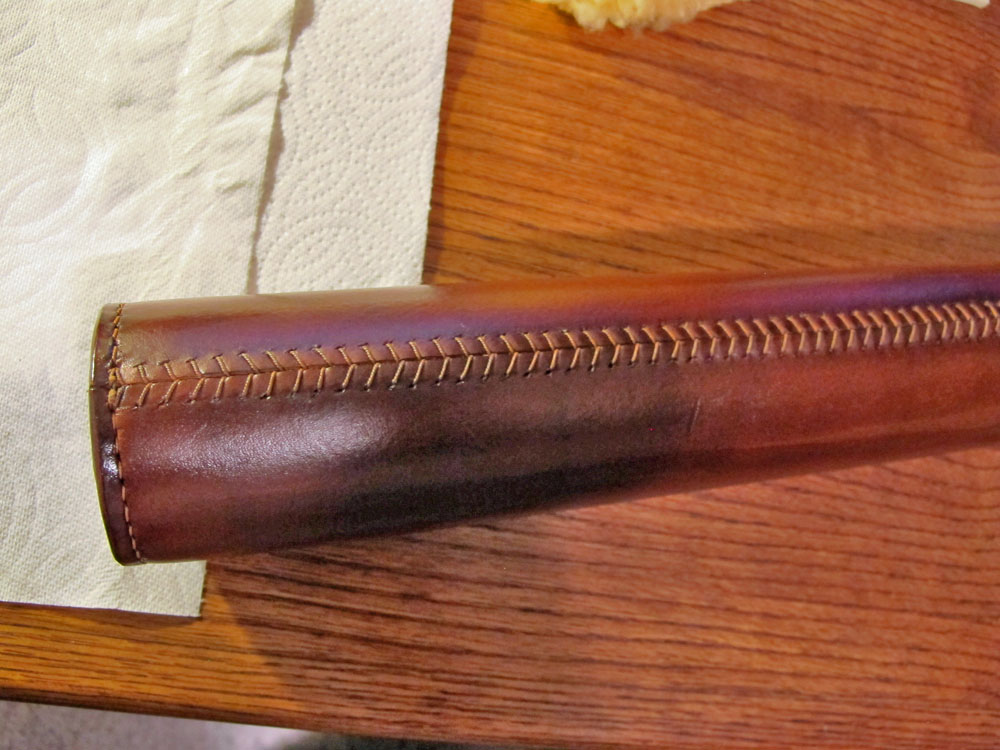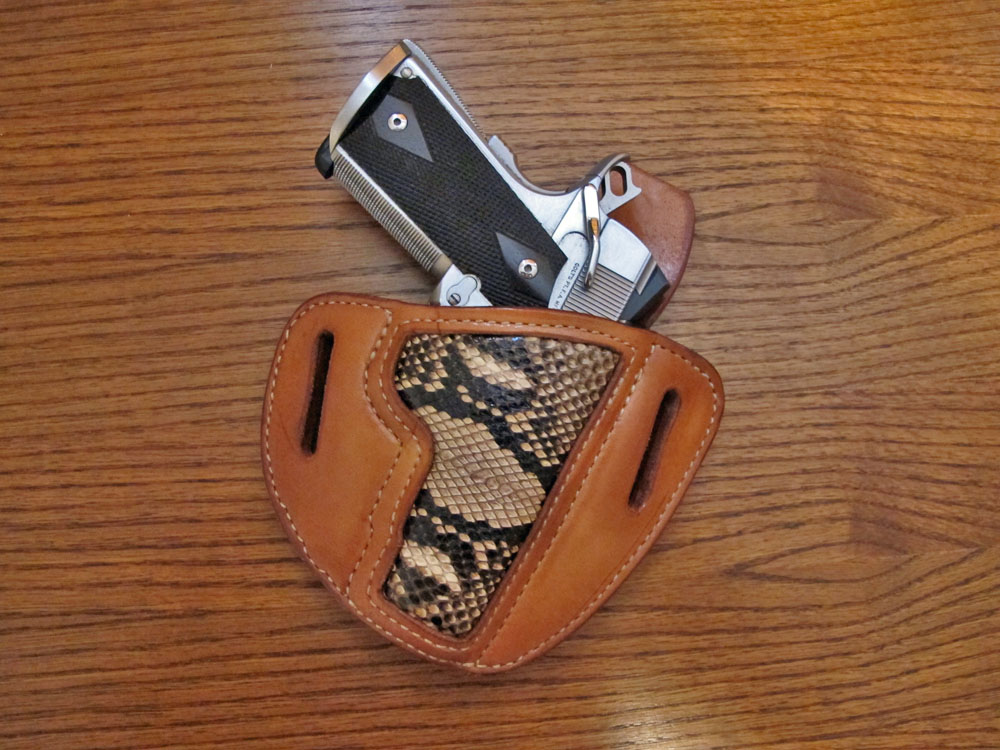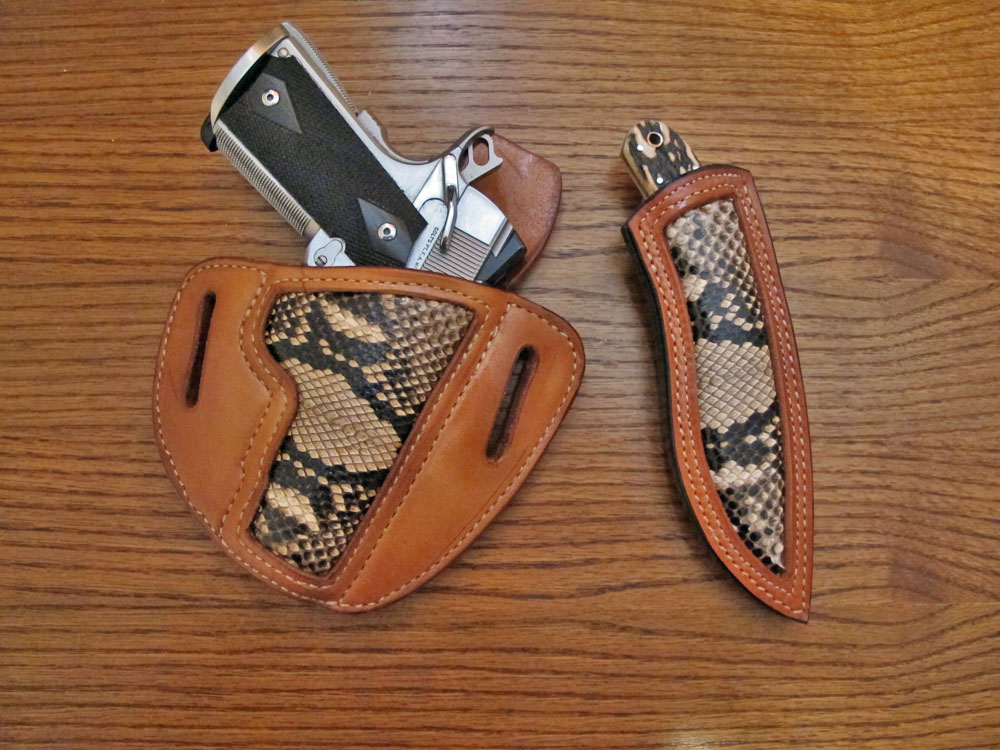
supercub
Members-
Posts
135 -
Joined
-
Last visited
Content Type
Profiles
Forums
Events
Blogs
Gallery
Everything posted by supercub
-
I bought a Boss when they first came out. It took awhile to get it (and me) adjusted to it's quirks. Once I did, it worked fine. I eventually upgraded to a (then) new Ferdco Pro 2000. It too is a great machine, but wayyy more $$. As I recall the Boss was then around $800 and the Pro 2000 was over $5k. I still keep the Boss around for small jobs and specialty products. About 85% of the stuff I make is sewn on the Pro 2000. Nowadays the Cowboy and other Juki 441 clones are a lot more reasonable in price than the Ferdco. If I had to do it again with current machine availability, I'd probably just bite the bullet and get a good electric needle feed machine with a wide throat and reverse. The Boss can be a good machine, but it will never be practical as a production tool. It is a whole lot faster than hand stitching though.
-
Hydro/ vacuum formed knife sheath
supercub replied to ComputerDoctor's topic in Gun Holsters, Rifle Slings and Knife Sheathes
Lots of very good suggestions on this thread. I first used vacuum bags for knife sheaths almost 20 years ago and see a lot of the same issues I encountered. First, you really need to use heavier leather and a welt. Second, put the smooth side of vacuum the bag against the finished side of the leather and use a smooth piece of cardstock against the bag's hatch pattern to prevent unwanted marks on your sheath. Third, be careful with high detailed molding since it is easy to make a sheath that is too tight. A final suggestion that worked for me when vacuum molding with food saver bags - put the sealed bag/knife/sheath in the freezer until the leather is hard. Remove the bag from the frozen sheath and leave it in the freezer for a few hours so it can "freeze dry" (works best with a frost free freezer). It won't dry completely, but it will evaporate a lot of the moisture and retain its shape so that it can air dry without loosing detail. Looks like you've got a good start. A little tweaking and it ought to work out well. -
Stitching through Kydex and leather with a Shapeoko CNC
supercub replied to joshhartung's topic in 3D Printers and Lasers
Several years ago I got an order for a hybrid kydex holster and mag pouch. The customer wanted the kydex fronts stitched to a 10 oz. leather back. I sewed them together with my Ferdco Pro 2000 (Juki 441) using 277 top thread and 207 bottom. It worked just fine. I did a minor adjustment to thread tension and the results were good. I didn't like working with kydex, so that was my only experience with it. Sewing it was no problem with that machine. Sorry, have no pictures of that project. I would expect any of the comparable heavy stitchers would work as well. -
They do make line 20 anvils as well as “pull the dot” snap setters. If I could have only one snap setter the Pess-N-Snap would be it. I’ve used mine for years with no complaints.
-
It’s been awhile since I found the O ring, and I looked for it at just about every local place I thought might have one. I went to every auto parts shop and industrial equipment supplier in my area. I finally found one that would work at a vacuum cleaner repair shop. It wasn’t an exact fit, but it was close enough to work. Mine uses an O ring that is approximately 1 7/16” OD and 1 1/8” ID and 3/16” thick. I later found the “right “ O-ring , but darned if I can remember where. I think it was at one of the machine vendors on this site who handle the CB machines. Seems like the rings were only a couple of bucks. The juki parts manual I have doesn’t show this part and I wonder if it wasn’t one of Ferd’s mods.
-
Have you talked to Bob at the Hickman Saddle shop in Post Falls? He may know of someone who can help you. Another one to ask is Dick's Upholstery in Hayden. Not sure what they use for machines, but they may know of a good repair tech.
- 6 replies
-
- walking foot repairs
- overhaul
- (and 9 more)
-
I bought one of the original cast iron Boss stitchers when they first came out. There was a bit of a learning curve with getting thread tension and a couple of other minor quirks. After I figured it out, it worked well and did pretty much what I wanted it to do. It paid for itself quickly and was a whole lot faster than hand stitching. I eventually upgraded to a Juki/Ferdco pro 2000, but I still use the Boss for small projects. One comment about Tippmann customer service. It is first rate! I needed a new center presser foot for the machine. Called the factory and they shipped one right out. Only problem was that it didn't work. It was made for their newer machines - which had subtle changes from my old model. Long story short - they machined a new part for me that fit perfectly. Too many other outfits will just say, "sorry your machine is no longer made and parts are not available".
-
Yep, the mat cutter does a great job (if you keep the blade sharp). I started using one a few years ago - wish I had thought of it when I made these reel cases. Minor correction re: the reels. The small cases were for Billy Pate reels and the large one was for a Bogdan saltwater.
-
Its been 20+ years since I made those cases and my memory isn't what it used to be. As I recall, most of the smaller cases are for Ross reels and the interior of the cases are inletted to fit each reel. The owners did not want shearling lining to avoid trapping moisture against the stored reel. The larger case was lined with shearling per that customer's request. As for building them, I made a wooden "plug" to approximate the exterior dimensions of the reel. I then cut out a cardboard pattern and fit it to the plug. Once I had the pattern perfected (lots of cutting and scotch tape) I cut out the leather pieces and started stitching. I looked for a box stitching attachment for my harness stitchers, but the ones I found just didn't work very well. The old fashioned awl and harness needle method seemed to work best. If I ever do them again, I'll spend more time on a 45 degree mitre for all the corners. These corners are all butt jointed. The rod case end caps are sewed with a similar corner stitch - though mitred. I had originally planned to sew the long seam with a curved awl and needles with a "hidden stitch", but I wasn't satisfied with the quality of my stitching and ended up with the baseball stitch. If you plan to do one of these, you'll certainly get lots of stitching practice.
-
I agree that the Stohlman case making books are a very good guide. A number of years ago I had a request for several fly reel cases for high end fly reels. I had only a vague idea of how to build one, so I tried to copy a design that Stohlman had for a camera lens case in' Making Leather Cases - Vol One'. They turned out okay, but they were an awful lot of effort. I sure didn't make any money off them. At least I was able to practice lots of corner stitching. Later, I made a rod case with leather covered PVC tube. I used the baseball stitch since I hadn't tried that before. Next time I might do something a little different.
-
I bought one of these years ago after messing up many snaps with the old hammer and anvil setters. It was money well spent. They also make a die set for "pull the dot" snaps which works well.
-
Thanks for the suggestions guys. Years ago I tried some "oil darkening" additive available from one of the large leather supply vendors. It didn't work as well as I had hoped - color was blotchy and the smell was objectionable. I'll try the Fiebings dye mix on the next project. The sun lamp is another option - I had forgotten about Bianchi's suggestion in the gunleather video.
-
I'm looking for a way to darken my oil finished holsters without dye. Ordinarily, I rub on a couple of coats of pure neatsfoot oil with a shearling pad onto the completed holster and let the oil migrate through the leather for a day or so. If it was summer, I'd set out in the sun to "tan" for awhile. This time of year, the sun isn't too bright and it is often overcast or raining. I was wondering if exposure to a UV tanning type lamp or full spectrum light would help to darken the finish? Anybody try this?
-
Flat back pancake (Flatcake?)
supercub replied to supercub's topic in Gun Holsters, Rifle Slings and Knife Sheathes
Yep, It's pretty much a SWAG on the 70%.. Anyhow, it's more than 50% molded on the front. Most of the flat backs I've done in the past have the front molded, then sewn (after drying) to the unmolded back. On this one, I sewed it flat, and wet the front panel trying to keep the back fairly dry. The thinner leather on the front helped too. You probably noticed that I "borrowed" the overall outline of your Colt Commander holster pattern and modified it for the XDS - thanks! As for the Saddle Lac - yeah, I'm not a fan, but that was what he wanted, and it is easy to touch up and restore after wear. I re dyed and finished a belt with the same finish that had been in daily use for at least two years. Looked pretty good after refinishing (or at least it matched the holster and mag pouch). -
A friend brought over a new XDS for a holster and wanted something a little different than a standard pancake. So, I did a semi flat back 70% molded front). Used 7/8 oz HO on front and 8/9 oz on the back. He also wanted a shiny black finish -- so break out the Saddle Lac. Not my favorite finish, but he was happy.
-
Ruger Super Blackhawk Cowboy Holster
supercub replied to SLP's topic in Gun Holsters, Rifle Slings and Knife Sheathes
I've looked at your holster a number of times, and the more I look, the more envious and depressed I get - especially when I compare it to my holsters. No matter how careful I am, I have never been able to get close to the high quality of this holster. Great Job! How did you dye the contrasting border so evenly? Airbrush? Q-tip? Artists brush? -
I have the French box stitcher attachment for the Tippmann Boss. It looks very similar to the Artisan unit. I have tried to use it on a number of occaisions with very limited success. Like others have said, you need at least 3 hands to operate it with the Boss. It is also limited by its inability to adjust the stitch row distance from the edge of the box. The stitch line is around 1/8" from the edge and you pretty much need to miter the leather edges to get a good seam. Some means of adjusting the distance from the box edge to the needle would be a valuable feature. I also had a tough time getting consistent stitches ( both in length and tension). As far as turning a corner 90 degrees - forget it. I eventually used it as a hole puncher on long runs (fishing rod case) and hand stitched the box seams. If you have any protruding features like snaps, belt loops, straps or buckles, they will interfere with seam alignment and will mess up the stitch line. I find it almost as easy to do it the old fashioned way with a conventional awl and harness needles per the directions in Stohlman's book. Unless you can set it up to sew one specific product on a dedicated machine, I found it to be a p.i.t.a. to adjust and configure. I wish it worked better. If it did, I'd make more boxes and cases.
-
First attempt - cigar tube
supercub replied to Mark Peters's topic in Purses, Wallets, Belts and Miscellaneous Pocket Items
If this is your first attempt at stitching a tube you did really, really well. I've made a number of fishing rod and spotting scope cases over the years and was never really satisfied with my attempts at this type of stitch. Sewing the end caps in place was easy for me compared to the main seam. Looks like you have it figured out. Whether it was the curved needle or awl, I found it really difficult to get the stitches even. As a result, I shifted over to a 'baseball' stitch (which works, but gives a different look). I'm impressed with your work and look forward to seeing more of it. -
Tell me about your "Hot Box"
supercub replied to Dwight's topic in Gun Holsters, Rifle Slings and Knife Sheathes
Or, you can do what I do. I use a food dehydrator similar to this one. Variable temperatures adjustable from room temp up to around 160 degrees. And, it does a pretty good job making jerky! Cabela's has one for around a hundred bucks. I got mine at JC Penny a number of years ago. -
A few weeks ago I ordered a center presser foot for my old Boss stitcher. It showed up fairly quickly and I installed it on my machine. Unfortunately, the needle would bind against the back of the presser foot on the upstroke resulting in a short stitch and no way to adjust stitch length. I called Tippmann and explained the problem to them. Turns out my machine was one of their very early first year models and the current versions of the Boss have some subtle (but significant differences). They told me they would try to come up with a presser foot that would work for me. About a week later a 'modified' foot arrives. It worked a little better, but it was still not quite right. Another call to the factory and a more detailed explanation resulted in a third modification. This time, it was PERFECT! Too many times, I've dealt with other companies who wouldn't bother supporting their older models and would just say, "sorry we don't carry those parts anymore - you need to buy a new upgraded machine". Even though it took a little time and effort, I'm happy with the response from Al and the other folks at Tippmann who made the extra effort to do the right thing. Even though I have other, higher end machines, the old Boss still works well when called upon. I expect it to keep working for a long time, and know that I can continue to get good service from the folks at Tippmann.
-
Officer's model python
supercub replied to supercub's topic in Gun Holsters, Rifle Slings and Knife Sheathes
Yep, its the 3.5" Officer's Model, albeit heavily modified. Sorry for the confusion on 'Python'. I realized it would be confusing right after I posted. This one is based on your Commander holster pattern ( cut down a bit), thanks. -
I had one last piece of Python skin that was almost big enough for a holster inlay. In order to make it work, I had to shrink the size of the inlay window. I would have liked to do it a little differently, but this is what I ended up with. At least it sorta matches the knife sheath I made a couple of weeks ago. Thanks to JLS for the basic outline, though I modified his pattern to fit the officer's model.


